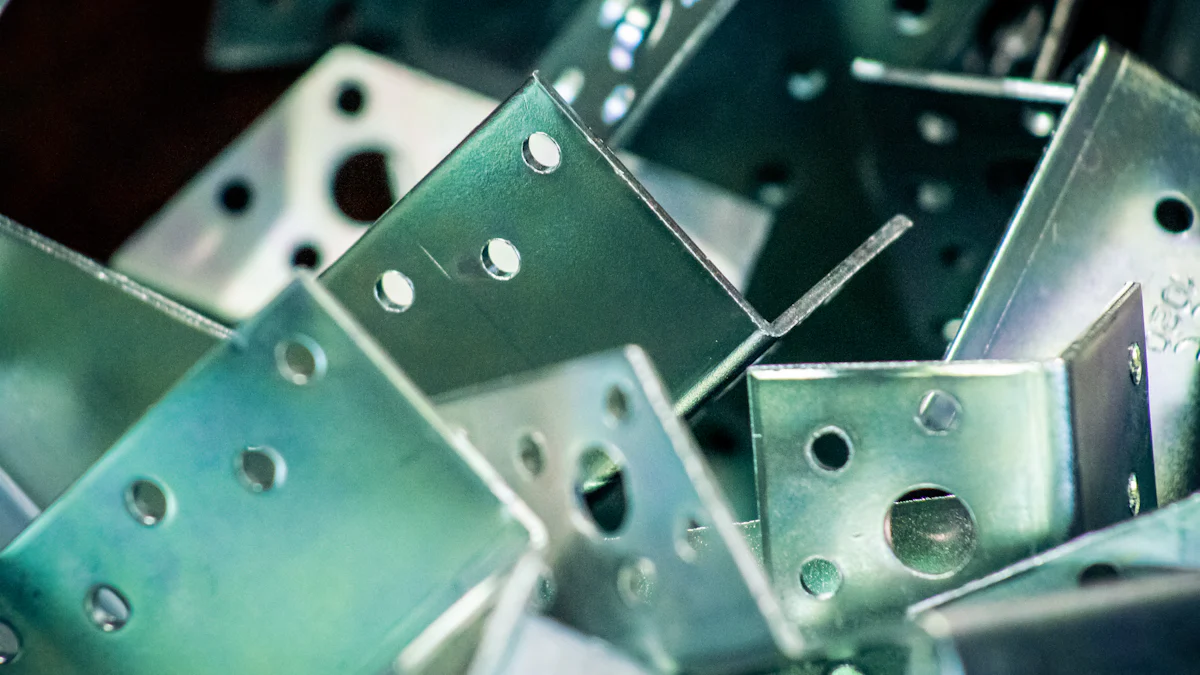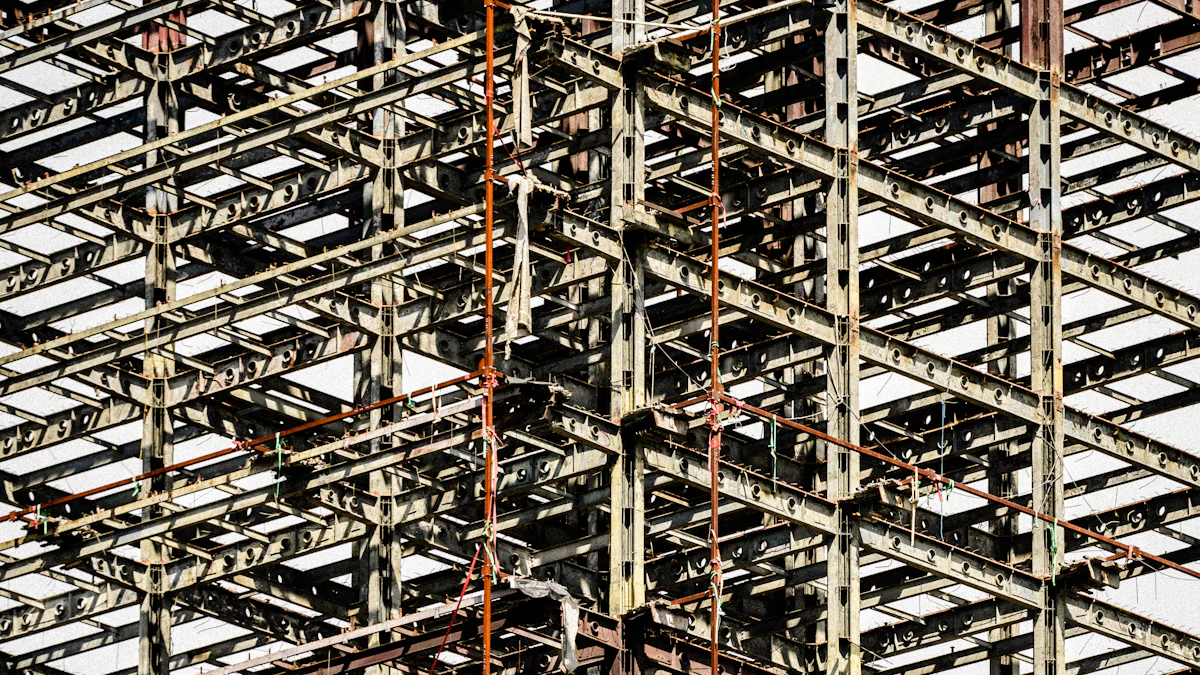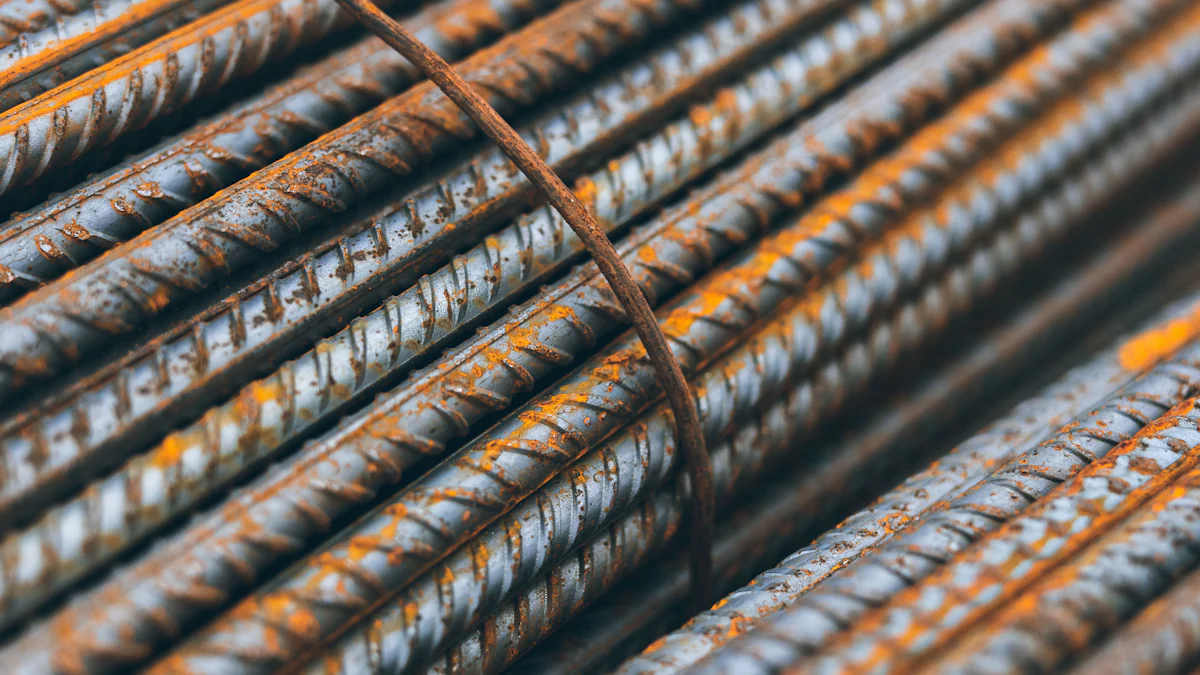The Role of Metal Substrate Materials in Modern Industry

Metal substrate materials play a pivotal role in modern industrial applications, driving advancements in technology and sustainability. Industries increasingly rely on these materials due to their unique properties and versatility. The global metal-based substrate market is projected to grow at a CAGR of 14.18% from 2024 to 2031, reaching USD 25.98 billion. Aluminum alloys, in particular, have revolutionized industries with their recyclability and reduced carbon footprint. Nearly 75% of all aluminum ever produced remains in use today, showcasing its enduring value. These materials continue to shape innovation and energy efficiency across diverse sectors.
What Are Metal Substrate Materials?
Definition and Key Characteristics
Composition and Properties of Metal Substrates
Metal substrate materials serve as the foundation for numerous industrial applications due to their exceptional properties. These materials typically consist of metals such as aluminum, steel, stainless steel, magnesium, and zinc. Each metal offers unique advantages, including strength, thermal conductivity, and corrosion resistance. For instance, aluminum alloys are lightweight yet durable, making them ideal for industries like automotive and aerospace. Similarly, stainless steel provides excellent resistance to rust and wear, ensuring longevity in harsh environments.
The properties of metal substrates extend beyond their composition. They exhibit high thermal conductivity, which is essential for heat dissipation in electronics and power systems. Their mechanical processability allows manufacturers to shape and customize them for specific applications. Additionally, these materials often include insulating layers, such as epoxy resin, to enhance their performance in electrical systems.
Commonly Used Metals: Steels, Stainless Steels, Aluminum Alloys, Magnesium Alloys, and Zinc Alloys
Industries rely on a variety of metals for substrate applications. Steels and stainless steels are known for their strength and durability, making them suitable for heavy-duty construction and infrastructure projects. Aluminum alloys, with their lightweight nature and recyclability, have become indispensable in modern industries. Magnesium alloys, prized for their low density, are increasingly used in automotive and aerospace sectors to reduce weight. Zinc alloys, on the other hand, offer excellent corrosion resistance and are often used in protective coatings and die-casting applications.
Differentiating Metal Substrates from Other Materials
Comparison with Ceramic and Polymer Substrates
Metal substrates differ significantly from ceramic and polymer substrates in terms of properties and applications. While ceramics provide excellent thermal stability and polymers offer flexibility, metals excel in mechanical strength and thermal conductivity. The table below highlights the defining characteristics of metal substrate materials:
Characteristic | Description |
|---|---|
Thermal Conductivity | Metal substrates exhibit good thermal conductivity, essential for heat dissipation in applications. |
Electrical Insulation Properties | They possess electrical insulation properties, which are crucial for preventing short circuits. |
Mechanical Processability | Metal substrates can be easily processed mechanically, allowing for versatile manufacturing. |
Composition | Typically composed of metals like aluminum, copper, iron, or silicon steel, along with insulating layers. |
Insulating Medium Layer | Uses high thermal conductivity epoxy glass fiber cloth or epoxy resin for insulation. |
Thickness of Insulating Dielectric Layer | Ranges from 80um to 100um, providing effective insulation. |
Thickness of Metal Plate | Varies from 0.5 mm to 3.0 mm, allowing for different application requirements. |
Advantages of Metal Substrates in Industrial Applications
Metal substrates offer several advantages over other materials. Their superior thermal conductivity ensures efficient heat management, which is critical in electronics and renewable energy systems. Their mechanical strength and durability make them ideal for construction and heavy machinery. Furthermore, their recyclability aligns with the growing demand for sustainable and eco-friendly solutions in industries. As construction trends for 2025 emphasize modular and prefabricated construction materials, metal substrates are poised to play a pivotal role in shaping future construction materials.
Applications of Metal Substrate Materials in Modern Industry

Electronics and Semiconductor Industry
Use in Printed Circuit Boards (PCBs) and Heat Sinks
Metal substrate materials play a critical role in the electronics industry, particularly in printed circuit boards (PCBs) and heat sinks. These substrates provide excellent thermal conductivity, ensuring efficient heat dissipation in power electronics. Aluminum-based substrates are widely used in PCBs due to their lightweight nature and ability to handle high thermal loads. This makes them indispensable in advanced electronics, where compact designs and high performance are essential. Heat sinks, often made from aluminum alloys, further enhance thermal management by preventing overheating in power-intensive devices.
Role in Miniaturization and High-Performance Devices
The demand for smaller, more powerful electronics has driven the adoption of metal substrates. Their mechanical strength and thermal properties enable the miniaturization of components without compromising performance. In semiconductors, these substrates support high-speed operations and improve device reliability. As a result, they are integral to the development of cutting-edge technologies, including smartphones, laptops, and power electronics systems.
Automotive and Aerospace Sectors
Lightweight and Durable Materials for Vehicle Components
Metal substrate materials, particularly aluminum alloys, dominate the automotive sector due to their lightweight and durable properties. These materials reduce vehicle weight, improving fuel efficiency and performance. Magnesium alloys also contribute to weight reduction while maintaining structural integrity. The table below highlights the role of metal substrates in key sectors:
Sector | Role in Market |
|---|---|
Automotive | Largest share of the metal-based substrate market |
Aerospace | Rising demand for metal substrates |
Construction | Increasing use of metal substrates |
Applications in Electric Vehicles (EVs) and Aircraft
Electric vehicles rely heavily on metal substrates for battery housings, thermal management systems, and lightweight structural components. Aluminum alloys, with their high strength-to-weight ratio, are essential for improving EV range and efficiency. In aerospace, these materials enhance fuel efficiency and reduce emissions by lowering aircraft weight. Their corrosion resistance ensures durability in extreme environments, making them ideal for both sectors.
Renewable Energy and Power Systems
Metal Substrates in Solar Panels and Wind Turbines
Metal substrates are vital in renewable energy systems, such as solar panels and wind turbines. Aluminum, which accounts for over 85% of demand in solar photovoltaic applications, is used extensively in panel frames and reflective surfaces. Its lightweight and corrosion-resistant properties make it suitable for both onshore and offshore wind energy projects. These substrates improve the efficiency and longevity of renewable energy systems.
Enhancing Energy Efficiency and Durability
Metal matrix composites (MMCs), like aluminum-silicon carbide (AlSiC), enhance heat dissipation and thermal management in power systems. Their lightweight nature reduces component weight while maintaining structural strength. Additionally, their corrosion resistance ensures durability in harsh environmental conditions. These attributes make metal substrates indispensable in renewable energy applications, supporting the global shift toward sustainable power solutions.
Focus on Aluminum Alloy Applications
Use in Lightweight Automotive Parts and Aerospace Structures
Aluminum alloys have become indispensable in the automotive and aerospace industries due to their lightweight and durable properties. These materials significantly reduce the weight of vehicles, enhancing fuel efficiency and performance. In electric vehicles, aluminum alloys play a crucial role in battery enclosures, thermal management systems, and structural components. Their high strength-to-weight ratio ensures safety and reliability while improving energy efficiency.
In aerospace, aluminum alloys contribute to the development of lightweight aircraft structures. They reduce overall weight, which improves fuel efficiency and lowers emissions. Their corrosion resistance ensures durability in extreme environments, such as high altitudes and varying temperatures. Aircraft manufacturers rely on these alloys for fuselage panels, wing structures, and landing gear components. The ability to withstand mechanical stress while maintaining a lightweight profile makes aluminum alloys a preferred choice in both industries.
Role in Renewable Energy Systems and Electronics
Aluminum alloys are vital in renewable energy systems and electronics due to their versatility and performance-enhancing properties. In renewable energy systems, these alloys are widely used in solar photovoltaic (PV) components, wind turbines, and energy storage solutions. The table below highlights their contributions:
Application Type | Aluminum Alloy Contribution |
|---|---|
Solar PV Components | Accounts for over 85% of mineral material demand |
Wind Energy | Used in on-shore and off-shore projects, including turbines |
Energy Storage | Potential in aluminum-ion batteries |
These alloys enhance structural integrity in renewable energy systems through their lightweight and durable nature. Their corrosion resistance ensures longevity and reliability, even in harsh environments. Aluminum alloys are commonly used in solar panel frames and wind turbine components, where their versatility supports diverse applications.
In electronics, aluminum alloys improve thermal management and structural performance. They are integral to heat sinks, printed circuit boards, and casings for high-performance devices. Their excellent thermal conductivity ensures efficient heat dissipation, which is critical for maintaining the functionality of compact and powerful electronic components.
Note: The widespread use of aluminum alloys in construction, electric vehicles, and renewable energy systems underscores their importance in modern industry. Their recyclability further aligns with global sustainability goals, making them a cornerstone of eco-friendly innovation.
Recent Advancements in Metal Substrate Materials
Innovations in Manufacturing Techniques
Additive Manufacturing and 3D Printing
Additive manufacturing and 3D printing have revolutionized the production of metal substrates. Technologies like SPEE3D's Cold Spray Additive Manufacturing (CSAM) enable the creation of dense, strong metal parts on demand. This method eliminates the need for high temperatures, reducing material distortion and enhancing efficiency. It also supports the use of diverse materials, making it a cost-effective alternative to traditional methods like casting and forging. These advancements allow manufacturers to produce complex geometries, meeting the demands of advanced electronics and power electronics systems.
Advanced Coating and Surface Treatment Technologies
Innovations in coating and surface treatment technologies have significantly improved the performance of metal substrates. Advanced adhesive technologies, including structural adhesives and self-healing adhesives, enhance durability and reliability. These coatings provide superior resistance to wear and corrosion, ensuring the longevity of components in power electronics and other applications. Surface treatments also optimize thermal conductivity, making them essential for next-generation materials used in semiconductors and electronics.
New Material Compositions
Development of High-Performance Alloys
The development of high-performance alloys has expanded the capabilities of metal substrates. High-performance Insulated Metal Substrates (IMS) now feature dielectric layers that improve thermal conductivity by over 20%. Flexible IMS substrates, designed for wearable electronics, can bend to a radius of less than 10 mm. These new materials also include environmentally friendly IMS options with halogen-free flame retardants, reducing environmental impact by approximately 20%. Such advancements cater to the growing demand for sustainable and high-frequency applications, particularly in 5G and electric vehicle power modules.
Integration of Nanomaterials for Enhanced Properties
The integration of nanomaterials, such as graphene composites, has elevated the performance of metal substrates. These materials enhance thermal and electrical conductivity, making them ideal for power electronics and advanced materials. Nanomaterials also improve the mechanical strength and flexibility of substrates, enabling their use in diverse applications. Research into these next-generation materials continues to drive innovations, ensuring that metal substrates meet the evolving needs of modern industries.
Enhanced Performance and Durability
Improved Thermal and Electrical Conductivity
Metal substrates now offer improved thermal and electrical conductivity, critical for power electronics and advanced electronics. High-performance IMS substrates reduce signal loss by up to 15%, ensuring efficiency in semiconductors and other components. These advancements support the development of compact, high-performance devices, meeting the demands of industries like renewable energy and electronics.
Resistance to Corrosion and Wear
Enhanced resistance to corrosion and wear has extended the lifespan of metal substrates. Advanced coatings and surface treatments protect components from harsh environmental conditions, ensuring reliability in power systems and other applications. These improvements make metal substrates indispensable for industries requiring durable and efficient materials.
The continuous research and development of new materials and manufacturing techniques ensure that metal substrates remain at the forefront of industrial innovation.
Advancements in Aluminum Alloys
New Alloying Techniques for Improved Strength and Flexibility
Aluminum alloys have undergone significant advancements to meet the demands of modern industries. Researchers have developed new materials that enhance strength, flexibility, and durability. These innovations cater to applications requiring lightweight yet robust substrates, such as aerospace and automotive sectors. The table below highlights key advancements in aluminum alloys:
Alloy Type | Advancements | Benefits |
|---|---|---|
2524-T3 | 20% increase in fracture toughness | Improved durability |
2026 | Enhanced fatigue performance and damage tolerance | Better reliability |
7000 series | High strength-to-weight ratio | Cost-effective for aerospace |
7475 | Enhanced strength and toughness | Improved performance in corrosive conditions |
2024 | Fatigue strength is 70% of yield strength | Suitable for high-stress applications |
These advancements demonstrate the versatility of aluminum alloys in creating advanced materials for high-performance applications. For example, the 7000 series alloys, with their exceptional strength-to-weight ratio, have become a preferred choice in aerospace engineering. Similarly, the 2026 alloy offers enhanced fatigue resistance, making it ideal for automotive components subjected to repetitive stress. Ongoing research continues to refine these alloys, ensuring they meet the evolving needs of industries.
Enhanced Recyclability and Eco-Friendly Production Methods
The aluminum industry has prioritized sustainability by adopting innovative recycling methods and eco-friendly production techniques. Aluminum is 100% recyclable and retains its properties indefinitely, making it a cornerstone of sustainable manufacturing. The table below outlines modern recycling methods and their environmental benefits:
Recycling Method | Description | Environmental Benefit |
|---|---|---|
Direct Recycling (DR) | A one-step process generating a final product without pre-processing. | Reduces energy consumption and resource use. |
Semi-Direct Recycling (SDR) | More effective than traditional methods, using solid-state processes. | Notable energy savings and greener alternatives. |
Traditional Recycling Techniques | Involves melting and adjusting alloy composition. | Minimizes environmental degradation. |
Recycling aluminum significantly reduces the need for virgin material extraction, conserving energy and water resources. The North American aluminum industry has reduced its carbon footprint over the past 30 years, showcasing its commitment to sustainability. Semi-direct recycling methods, which utilize solid-state processes, offer greener alternatives by minimizing energy consumption. These advancements align with global efforts to reduce environmental impact while maintaining the high performance of aluminum substrates.
Aluminum's recyclability and eco-friendly production methods position it as a leader in sustainable materials. Its ability to support renewable energy systems and advanced materials ensures its continued relevance in modern industries.
Addressing Sustainability and Environmental Challenges
Eco-Friendly Manufacturing Processes
Reduction of Waste and Energy Consumption
Manufacturers are adopting innovative methods to minimize waste and energy use in the production of metal substrate materials. These methods include energy-efficient production techniques and the use of non-toxic metals. By optimizing manufacturing processes, companies reduce their environmental footprint while meeting the growing demand for sustainable products. For example, metallized ceramic substrates now incorporate eco-friendly materials, which significantly lower their impact on the environment. These advancements align with global efforts to conserve resources and promote sustainability.
Use of Recycled and Sustainable Materials
Recycling plays a pivotal role in the sustainability of metal substrates. Approximately 80% of all aluminum ever produced remains in use today, highlighting its enduring value. During production, 100% of metal scrap is recycled back into the manufacturing process, ensuring minimal material loss. Consumers also contribute by recycling aluminum cans at more than twice the rate of plastic bottles. This aligns with the Circular Economy model, which eliminates waste by continuously cycling materials through the value chain. This approach conserves natural resources and reduces emissions, making it a cornerstone of sustainable and eco-friendly materials.
Lifecycle and End-of-Life Considerations
Designing for Recyclability and Reuse
Designing metal substrates with recyclability in mind ensures their long-term sustainability. Engineers focus on creating products that can be easily disassembled and reprocessed at the end of their lifecycle. This approach not only reduces waste but also conserves valuable raw materials. For instance, aluminum substrates are designed to retain their properties indefinitely, making them ideal for reuse in various applications. Such practices support the global shift toward a circular economy.
Minimizing Environmental Impact of Disposal
Proper disposal methods further enhance the environmental benefits of metal substrates. Recycling facilities process discarded materials to recover valuable metals, reducing the need for virgin material extraction. This minimizes the environmental impact associated with mining and manufacturing. By prioritizing eco-friendly disposal practices, industries contribute to a cleaner and more sustainable future.
Supporting Green Technologies
Role in Renewable Energy Systems
Metal substrates are essential in renewable energy systems, such as solar panels and wind turbines. Aluminum, widely used in these applications, improves efficiency and durability. Its lightweight and corrosion-resistant properties make it suitable for both onshore and offshore wind projects. These materials enhance the performance of renewable energy systems, supporting the global transition to sustainable power solutions.
Contribution to Carbon-Neutral Industrial Practices
The use of metal substrates aligns with carbon-neutral industrial practices. Recycled materials reduce the energy required for production, lowering greenhouse gas emissions. Additionally, advancements in manufacturing processes further decrease the carbon footprint of these materials. By integrating metal substrates into green technologies, industries move closer to achieving carbon neutrality.
The adoption of sustainable practices in manufacturing and recycling ensures that metal substrates remain a vital component of eco-friendly innovation.
The Future of Metal Substrate Materials
Trends Shaping the Industry
Increased Demand for Lightweight and Multifunctional Materials
The demand for lightweight and multifunctional materials continues to grow across industries. Metal substrates, particularly aluminum alloys, are at the forefront of this trend due to their ability to combine strength, durability, and reduced weight. This shift is driven by the need for advanced materials in sectors like automotive, aerospace, and electronics. Emerging markets in Asia-Pacific and Latin America are fueling this growth, with the global metal substrate market projected to reach USD 25.98 billion by 2031. These materials are also gaining traction as future construction materials, aligning with construction trends for 2025 that emphasize modular and sustainable designs.
Integration with Smart Technologies and AI
Smart technologies and AI are transforming the metal substrate industry. These advancements enhance efficiency, customization, and environmental impact. For instance:
AI-powered design software analyzes data to optimize substrate performance.
Smart materials for intelligent buildings integrate sensors to monitor conditions and regulate temperature.
Virtual and augmented reality technologies detect abnormalities and provide precise measurements.
These innovations position metal substrates as next-gen building supplies, meeting the demands of modern infrastructure and electronics.
Potential Breakthroughs
Self-Healing and Adaptive Materials
The development of self-healing and adaptive materials represents a significant breakthrough in metal substrates. These materials can repair damage autonomously, extending their lifespan and reducing maintenance costs. Researchers are also optimizing substrate designs to improve thermal and electrical conductivity while reducing weight and cost. The integration of features like antennas and sensors into substrates further enhances their functionality, making them indispensable in electronics and renewable energy systems.
Innovations in Hybrid Substrates Combining Metals with Other Materials
Hybrid substrates that combine metals with ceramics or polymers are emerging as a game-changer. These substrates offer enhanced properties, such as improved corrosion resistance and mechanical strength. By leveraging the best attributes of multiple materials, hybrid substrates support the creation of advanced materials for high-performance applications. This innovation aligns with the growing demand for multifunctional solutions in industries like aerospace and electronics.
Challenges and Opportunities
Balancing Cost, Performance, and Sustainability
Balancing cost, performance, and sustainability remains a critical challenge for the metal substrate industry. High raw material costs and stringent environmental regulations increase production expenses. Intense market competition and the availability of substitutes like ceramics and plastics further complicate this balance. However, the adoption of sustainable practices and the use of recycled materials present opportunities to address these challenges effectively.
Meeting the Needs of Rapidly Evolving Industries
Rapidly evolving industries demand continuous innovation in metal substrates. The automotive sector seeks lightweight materials to improve fuel efficiency, while the electronics industry requires substrates with excellent conductivity for portable devices. The aerospace sector relies on these materials for thermal management and electrical distribution systems. The table below highlights key growth drivers across industries:
Industry | Projected Growth Rate | Key Drivers |
|---|---|---|
Automotive | Significant | Demand for lightweight and durable materials to improve fuel efficiency and performance. |
Electronics | Significant | Rise in demand for smartphones, tablets, and portable devices due to excellent conductivity. |
Aerospace | Significant | Use in electrical distribution systems, antennas, and thermal management applications. |
The rapid adoption of AI, automation, and IoT further reshapes industry practices, creating new opportunities for metal substrates to meet evolving demands.
The future of metal substrate materials lies in their ability to adapt to technological advancements and sustainability goals. By addressing challenges and leveraging opportunities, these materials will continue to drive innovation across industries.
Chemical Elements in Aluminum Alloys and Their Effects

Aluminum alloys derive their versatility and performance from the addition of various chemical elements. These elements influence properties such as strength, corrosion resistance, machinability, and thermal conductivity. Understanding their effects is crucial for tailoring alloys to meet specific industrial requirements.
Table: Effects of Chemical Elements in Aluminum Alloys
The table below highlights the role of key chemical elements in aluminum alloys and their impact on material properties:
Element | Effect on Aluminum Alloys |
|---|---|
Antimony | Reduces hot cracking in aluminum-magnesium alloys. |
Arsenic | Toxic; requires strict control in food packaging applications. |
Beryllium | Minimizes oxidation at high temperatures in magnesium-containing alloys. |
Bismuth | Enhances machinability in free-machining alloys. |
Boron | Acts as a grain refiner and improves electrical conductivity. |
Cadmium | Accelerates age hardening, increasing strength and corrosion resistance. |
Calcium | Improves conductivity and affects strength in aluminum-silicon alloys. |
Chromium | Refines grain structure and prevents recrystallization in certain alloys. |
Copper | Boosts strength and hardness through heat treatment in aluminum-copper alloys. |
Magnesium | Increases strength, corrosion resistance, and weldability without reducing ductility. |
Manganese | Enhances strength while maintaining corrosion resistance. |
Lithium | Alters surface characteristics and promotes discoloration in wrought products. |
Iron | Forms intermetallic phases, which can negatively affect mechanical properties. |
Nickel | Commonly added to improve specific properties, though details vary by application. |
Influence of Chemical Compositions on Industrial Applications
Magnesium serves as a primary alloying element, significantly enhancing strength and corrosion resistance. Its ability to maintain ductility makes it ideal for automotive and aerospace components. Copper, another critical element, increases hardness and strength, particularly in heat-treated alloys. This property is essential for structural applications requiring durability under stress.
Manganese improves strength without compromising corrosion resistance, making it suitable for marine and transportation industries. However, impurities like iron can form intermetallic phases, reducing mechanical performance. Manufacturers often control iron content to ensure optimal alloy quality.
Note: The careful selection and combination of these elements allow engineers to design aluminum alloys tailored to specific industrial needs. This adaptability ensures their continued relevance in modern applications.
Metal substrate materials have become indispensable in modern industries, particularly in electronics, construction, and power systems. Aluminum alloys, as advanced materials, drive innovations in lightweight components and advanced electronics. Recent research has enhanced their thermal performance, making them vital for power electronics and eco-friendly applications. These substrates align with construction trends for 2025, offering future construction materials that meet evolving demands. As industries adopt new materials and technologies, these components will continue to shape the future of power systems and electronics, ensuring sustainability and efficiency.
FAQ
What are the primary benefits of using aluminum alloys in modern industries?
Aluminum alloys offer lightweight properties, high strength, and excellent corrosion resistance. These attributes make them ideal for automotive, aerospace, and renewable energy applications. Their recyclability also supports sustainability goals, reducing environmental impact while maintaining performance.
How do metal substrates improve thermal management in electronics?
Metal substrates, especially aluminum-based ones, provide superior thermal conductivity. This property ensures efficient heat dissipation, preventing overheating in electronic devices. Their use in printed circuit boards and heat sinks enhances the reliability and performance of compact, high-power electronics.
Why are aluminum alloys preferred in renewable energy systems?
Aluminum alloys combine durability, corrosion resistance, and lightweight properties. These features make them suitable for solar panel frames, wind turbine components, and energy storage systems. Their recyclability further aligns with the sustainability objectives of renewable energy technologies.
What advancements have been made in aluminum alloy manufacturing?
Recent advancements include additive manufacturing, new alloying techniques, and nanomaterial integration. These innovations enhance strength, flexibility, and thermal performance. Eco-friendly production methods and improved recyclability also contribute to the growing adoption of aluminum alloys in various industries.
How do chemical elements affect the properties of aluminum alloys?
Chemical elements like magnesium, copper, and manganese influence strength, corrosion resistance, and machinability. For example, magnesium enhances strength and weldability, while copper increases hardness. Engineers tailor alloy compositions to meet specific industrial requirements, ensuring optimal performance in diverse applications.
Tip: Understanding the role of chemical elements in aluminum alloys helps manufacturers design materials for specialized uses, ensuring efficiency and durability.
See Also
Enhancing Diecast Durability Through Electroplating Techniques
A Supplier's Guide to CBAM and Sustainable Casting
Leading Aluminum Labels in the US, EU, and China
Understanding Various Powder Coating Methods and Applications
The Environmental Advantages of Organic Coating by 2025
About Hunan Puka
Established in 2016 and based in Hunan, China, with a liaison point in Berlin, we are a Tier 2 supplier for the automobile industry. We specialize in the production of customized aluminum die-casting parts designed for machines with a closing force ranging from 280 to 800 tons, with subsequent manufacturing process CNC machining and surface treatment. Our commitment to quality is reflected in our accredited quality management system, certified by ISO9001:2015 and IATF16949:2016 standards.


